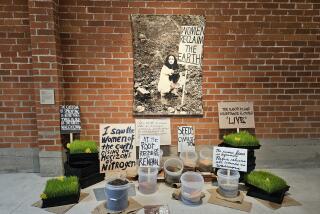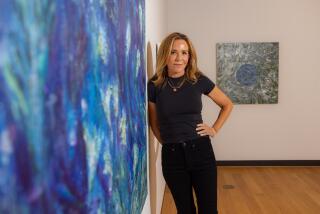From Dislocation, Artistic Direction
- Share via
NEW YORK — In her searingly white loft, with the cacophony of the SoHo streets far below, Israeli artist Michal Rovner reflects, “I had an image in my mind of being an artist in New York. I thought, if you make it here in terms of recognition for what you do, then you can convey the ideas you feel strongly about.”
Rovner came to New York in 1988, and has achieved plentiful recognition for her spare photographic images made from video recordings and computers as well as cameras. After her first solo show at the Art Institute of Chicago in 1993, Susan Snodgrass wrote in Art in America, “She shuns any romantic notion of humankind in harmony with nature. Instead, she fuses the ethereal and empirical worlds to address issues of mortality.”
Her first film, “The Border,” was screened before an audience of heavyweight collectors and curators at the Museum of Modern Art last April. London’s Tate Gallery is exhibiting her mural scale video-derived works and installation through Aug. 4. A selection of similar pieces opened at the Shoshana Wayne Gallery in Santa Monica this weekend.
Plants and rustic furniture painted in shades of sienna and sage soften the rigor of the artist’s loft space. An intense woman of 39 with cropped dark hair, Rovner has set out an elaborate tray of pastries, pa^tes and cheeses for a visitor; speaking in heavily accented English, she says, “I take food seriously.” After a pause, she adds, “I take everything seriously.”
Rovner slowly tears a bagel into smaller and smaller pieces as she talks about her career as an artist and her feelings about New York and Israel. “I’m interested in displacement, in moving something from its original context,” she says. Whatever her subject matter--a house, an animal, a person--it always is surrounded by undefinable, empty space. The sense of detachment in her art parallels and reflects her sense of her life after her move to New York.
Emigrating from her home outside Tel Aviv, where she grew up as the youngest of three children, was not an easy decision. In 1978, Rovner co-founded (with her future husband, Arie Hammer) the Camera Obscura School of Art in Tel Aviv. The school gained a good reputation for its courses in photography, video and cinema and its popular seminars with guest lecturers like photographer and filmmaker Robert Frank.
“For me, he was the most inspiring,” recalls Rovner. “At that stage, he had an immense effect on my career. He said, ‘You should go to America and become an artist.’ ”
Rovner completed her undergraduate studies in cinema and philosophy at Tel Aviv University in 1981 as well as a fine arts degree at Bezalel Academy of Art in 1985. In 1988, she took Frank’s suggestion, moved to New York, and in the early ‘90s, she worked with Frank on his films as scriptwriter and director’s assistant. “It was a very high-level friendship. I learned a lot from him,” she says.
“Israel is a very family-oriented society,” she explains. “I was married and the normal thing after so many years would be to create a family. I thought, before that happens, before I cement myself to the ground, I might have a last chance to take off to larger space that will enable me to grow as much as I thought I could. I always felt a bit shrunk in Israel. It is such a supportive society. There is so much warmth and kindness to protect you in a nation that has suffered so many traumas, but it has a price. The price is that it suffocates you at the same time. It demands a collectiveness and I felt I would like to grow larger without feeling that I make someone else smaller.”
“New York wants you to go high,” she adds. “You are supposed to make it. You get permission to be different. Plus, in New York they take art very seriously. You don’t have to be a doctor or a good soldier. In Israel, they ask, ‘But what about your life?’ This is my life.”
Nevertheless, her move to the city produced a sense of profound physical and emotional dislocation. “I was very alone when I came ,” she recalls. “I decided that I would stay until I could feel good about the place, that I had succeeded.”
“I grew up in a suburb where there were few houses and lots of fields and empty spaces.” Unable to connect with the urban landscape, her earliest attempts to make art in the big city were tiny tableaux of rural scenes with houses and trees as though seen from a great distance. “They were almost illustrative, an homage to what I’d left behind,” she explains.
In a similar vein, during the late ‘80s, she photographed taxidermic animals such as coyotes, foxes, and crows surrounded by empty space. Rovner says they are not meant to be flying: “Flying brings to mind wings, initiation, getting from one place to another,” says Rovner. “To me, it’s more about being taken out of context, being detached. It’s about being in between, after taking off and before landing.”
Rovner returned to Israel in 1990 and while driving to the Dead Sea, she passed a Bedouin house that she then made the subject of a haunting series of photographs called “Outside.” “It was so perfect in shape, like the essence of house, but vacant and with no doors or windows. It was isolated, in the middle of the desert, which was important to me. I just realized, looking back, that it was a time when I was divorcing my husband. I kept going back to this house wondering, ‘What does a house really mean?’ ”
In 1991, she attended an opening for this series of photographs at the Tel Aviv Museum, and had just returned to New York when the Gulf War broke out. “For the first time, I experienced war in Israel by being away but seeing it on TV,” she says. “On CNN, I knew a missile was on its way, before my parents. I could call them and tell them. A missile landed on their street and if they had been home, they would have been hurt. Every piece of glass in their house was broken.”
She took Polaroids from the television coverage of the war and altered and enlarged them as individual works. “I was fascinated by how beautiful and remote it looked,” she recalls. “There was such a gap between what I saw and what I knew.”
After the war, she returned to Israel to videotape the Bedouin house, but it had been destroyed. For her next series, she hired men to float in the Dead Sea and videotaped them from a great distance so they were reduced to dark smears against an indistinct and grainy background. The individually printed images are titled “One-Person Game Against Nature” based on a notion from game theory in international politics referring to the condition whereby one nation cannot play alone. “It can sound poetic but it isn’t,” she says.
Rovner notes that she hasn’t used a camera for the past few years and prints her images from videotape or computer. “I make recordings of recordings and make different generations so you lose something on the way but you gain something else. Like life. I try to reduce them visually. I try to erase more than I record yet still be left with the minimum that is necessary.”
In the last two years, Rovner has completed several site-specific works in Israel. To make durable banners on an architectural scale, she printed her images on rolls of neutral linoleum. She also used this process for “Dilemma,” a series of 44 flags hung above the Israeli-Lebanon border with images of crossed figures abstracted to look like an X facing both countries. Such border images address her feelings about the ongoing political strife in the Middle East, with people as targets.
Likewise, observing the exchange of gunfire there inspired her to attempt her film “The Border,” she says: “I think that the film is trying to convey the experience of tension and confusion. There is an attempt to have clarity, and annoyance that it is not going to be provided to you. It’s easy to find yourself on this side or other preaching. But this is an ongoing relationship based on mistrust, suspicion and fear. I am only dealing with aesthetics and not offering any solution.”
Moving from Israel, however, has allowed her to make work about it with a detached perspective. Is she ready to go home again? She looks amused and says, “I can live in New York and Israel and other places, too. You know how they say you can’t have the cake and eat it? I always fought against that idea. I think you can have your cake and eat it, too.”*
More to Read
The biggest entertainment stories
Get our big stories about Hollywood, film, television, music, arts, culture and more right in your inbox as soon as they publish.
You may occasionally receive promotional content from the Los Angeles Times.










